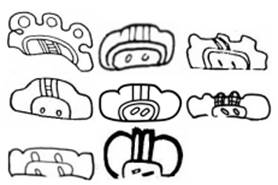![]()
![]()
![]()
K&H.p87.#9 TOK.p7.r2.c2 BMM9.p11.r2.c1
YAX YAX YAX

K&L.p33.#1
YAX
· Contrasting with CHAK:
o A full YAX and full CHAK are very easy to distinguish:
§ A full YAX is asymmetric – one side (the “inside” edge, which attaches to main signs) is smooth, while the other side (the “outside” edge, away from the main sign) has two tiny indentations, giving it a tri-lobate edge. In contrast, a full CHAK is rectangular/oval with no indentations on the outer edge.
§ A full YAX has – on the inside of the “inside” edge – an oval (optionally bold) with two non-touching dots, each with a “diagonal” alignment –sloping slightly NE-SW. In contrast, a full CHAK has two internal ovals, one on the inside of the inside edge and one on the inside of the outside edge. Each such oval has three non-touching very small dots; the dots don’t have a diagonal alignment and are perfectly round.
§ A full YAX has two non-touching bars/bands, optionally cross-hatched, from the oval to the “outside” edge. In contrast, a full CHAK also has two non-touching bars/bands, optionally cross-hatched, but they go from one of the internal ovals to the other.
§ A full YAX never has a single dot on the inside of each of the long ends of the outline. In contrast, a full CHAK does. These dots are not round, more semi-circles.
o In the more reduced forms, YAX can lose the two tiny bumps in the outline of the “outer” side and CHAK can lose one (or both) of its ovals. When this happens, it is difficult to distinguish YAX from CHAK – however, the absence of two small internal dots at the left and right end are a useful diagnostic for YAX. If there is erosion in such reduced forms, then CHAK can also lose the single dot on the inside of each of the long ends of the outline. When this happens – CHAK has also lost one internal oval – then it’s practically impossible to know if a YAX or CHAK was written.
· Contrasting with na:
o Like YAX, na also has two tiny indentations on the outer edge, giving it a tri-lobate edge.
o However, the distinguishing characteristics are:
§ There is a tendency for the “middle third” of the YAX outline stick out, whereas the “middle third” of na tends to be level with the outside two or even be slightly further in.
§ YAX has an internal oval on the “inside” edge with two non-touching, diagonally oriented dots, totally within the oval, while na has a curved reinforcement of the “inside” edge, with two (sometimes three) touching, round dots touching the curved reinforcement.